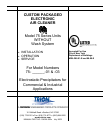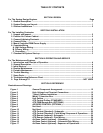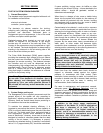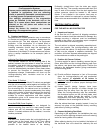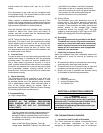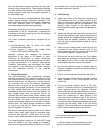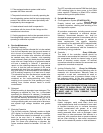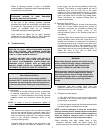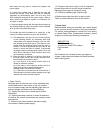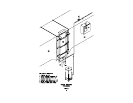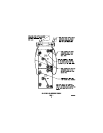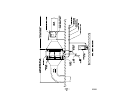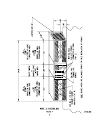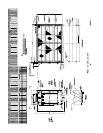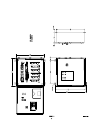
5
2. Filter-equipped exhaust systems shall not be
operated with filters removed.
3.The posted instructions for manually operating the
fire extinguishing system shall be kept conspicuously
posted in the kitchen and reviewed periodically with
employees by the management.
4. Listed exhaust hoods shall be operated in
accordance with the terms of their listings and the
manufacture instructions.
5. Cooking equipment shall not be operated while its
fire-extinguishing system or exhaust system is not
operating or otherwise impaired.
4. Routine Maintenance
A. Washing Frequency
The frequency that the collected dirt is to be washed
from the unit depends upon the type and amount of
dirt in the air to be cleaned. Dirt which is greasy in
nature tends to harden after collection and should
be washed away often. Likewise, units operating
under extremely heavy dirt loads should be washed
more often as a large build-up of collected material
will have a tendency to “blow-off” if permitted to
remain on the collecting elements for long periods
of time. In that the type and amount of dirt varies
geographically (and from one location to another in
any given area) it is recommended to start operation
with a washing frequency of at least once a week.
This schedule may then be altered as needed after
visual examinations of the collected material
contained on the ionizing-collecting cells. Daily
washing is not unusual for units operating on heavy
welding fume, kitchen exhaust hoods or similar
contaminants.
B. Detergent
Effective washing is dependent upon detergent. The
detergent, as supplied by Trion, Inc., is formulated
specifically for electronic air cleaners. If substitutes
are used, they must be approved by Trion, so as to
not void the warranty and should be safe for use in
ventilation systems and non-caustic, as 95% of the
ionizing-collecting cells are constructed of aluminum
and special high voltage insulation and gasket
seals.
C. Electrical Operation
The Air Boss controller (Optional) contains a digital
LED display for kilovolt and milliampere readings.
The milliammeter should be observed on a routine
basis to be sure that it is reading within the
prescribed operating range as marked on the data
plate. For those units containing a voltmeter, the
ionizer readings should be between 12.5 and 13.5
KV.
The ATS controller and remote PWM box both have
LED indicating lights to show power to the PWM
power supplies. Flickering or failed LED’s indicate
electrical arcing and/or power failure.
5. Periodic Maintenance
A. Fire Suppression System (IF INSTALLED) –
Every 6 Months
Properly trained and qualified personnel shall
complete inspection, cleaning and servicing of the
fire suppression system.
All actuation components, including remote manual
pull stations, mechanical or electrical devices,
detectors, fire-actuated dampers, etc., shall be
checked for proper operation in accordance with the
manufacturers listed procedures. In addition to
these requirements, the specific inspection
requirements of the applicable NFPA standard shall
also be followed. If required, certificates of
inspection and maintenance shall be forwarded to
the authority having jurisdiction.
B. Controller - Every 12 Months
The inside of the controller cabinet should be
examined for accumulated dirt and dust. If required,
the components should be cleaned using a good
brand of electrical contact cleaner. All terminal
connections should be checked for securement and
tightened or reworked as required.
C. Ionizing-Collecting Cell – Every 6 to 12 Months
Remove and inspect the ionizing-collecting cells for
excessive dirt accumulations. Manually clean as
required in a soak tank, commercial car wash, or
with a pressure hose or pressure cleaner using a
low pressure setting. At this time, particular care
should be taken in cleaning each of the insulators.
WARNING:
DO NOT USE HIGH PRESSURE STEAM CLEANING
EQUIPMENT TO CLEAN CELLS. THE EXCESSIVE
HEAT AND PRESSURE WILL CAUSE THE PLATES
TO WARP AND IN TURN POSSIBLY CAUSE
EXCESSIVE ARCING.
D. Filter Devices – Every 4 to 6 Months
Hoods, impingers, metal mesh filters, ducts and
other appurtenances shall be cleaned to bare metal
at frequent intervals prior to surfaces becoming
heavily contaminated with grease, oil or other
contaminate. It may be advantageous to clean
readily removable items, such as impingers, metal
mesh filters or other permanent filter devices in a
soak tank, with a pressure hose or pressure cleaner
set low. After cleaning to bare metal, components
shall not be coated with powder or other substance.



